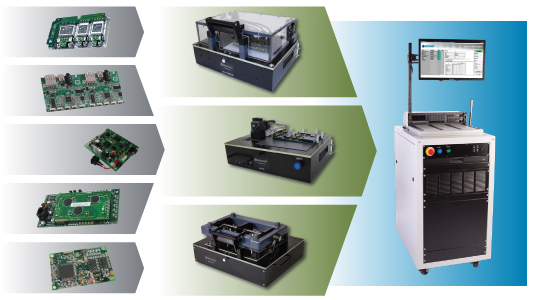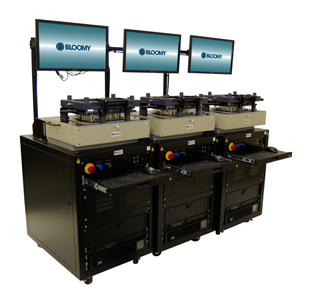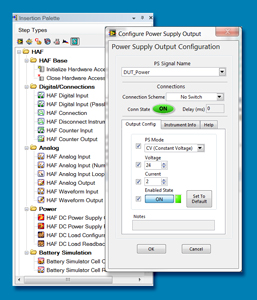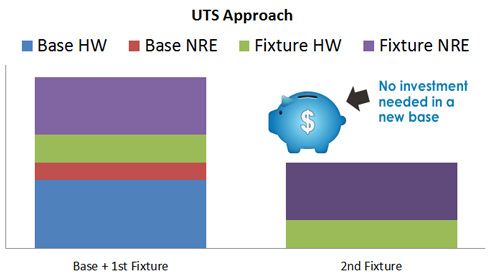Manufacturing functional test is a form of testing (different from design verification testing or in-circuit testing) that is used to test for manufacturing defects by exercising the unit under test (UUT) in a manner similar to its intended purpose. This typically involves a series of measurements, stimuli and responses, and communications with the unit to verify that all subsystems are operating as designed.
When we say “high-mix electronics manufacturing functional test” we are referring to manufacturing environments where functional test will be performed at one or more stages of assembly (PCBA, subassembly, final assembly), and/or on multiple different products. In high-mix environments, there is often a need to test a wide variety of assemblies at relatively low quantities.
 Knowing what we do about manufacturing functional test, let’s take a look at what we mean by “universal test” by using the Bloomy Universal Test System, UTS, as an example.
Knowing what we do about manufacturing functional test, let’s take a look at what we mean by “universal test” by using the Bloomy Universal Test System, UTS, as an example.
Often, each time a new product is developed, a test system must be developed for it. These test systems tend to be highly customized, containing specific instrumentation, circuitry, and mechanical interfaces required for verifying the validity of a particular product.
The UTS is an instrumentation and software platform geared towards a high-mix manufacturing environment. A UTS contains instrumentation selected to meet the needs of all of your products to be tested. The instrumentation is routed through mass interconnect receiver, which is a series of modular high-density connectors. Typically each connector corresponds to an instrument, or set of instruments. In this way, Interchangeable Test Adapters (also known as ITAs or fixtures), are developed to adapt the generic instrumentation at the receiver to the specific connections of each UUT. The end result is a single base system that is universal to your particular test needs, with customization required only at the ITA fixture head.
As outlined here, there are many benefits to a universal approach to automated functional test. Some of these benefits have a direct impact on reducing overall cost of test. Other benefits are more subjective, and provide advantages with regards to best practices, system longevity, and ongoing support. In this presentation we will discuss each of these benefits, and make a case for why universal test is the preferred long-term testing strategy for most product companies.
 Universal test systems are adaptable to many different products and product schedules.
Universal test systems are adaptable to many different products and product schedules.
A mass interconnect approach that utilizes interchangeable test adapters (ITAs or fixtures), means that you can test multiple different products on a single base test system. This effectively maximizes the up-time of costly instrumentation. In addition, a new product test only requires the development of a new ITA or fixture, rather than the entire test system.
In addition, by employing multiple test systems with duplicate ITAs, you can also adapt to changing manufacturing loads by spreading test across multiple systems in times of high demand, then returning to the standard high-mix routine when the demand returns to normal.
 Universal test systems are flexible, reducing the impact of requirements and equipment changes.
Universal test systems are flexible, reducing the impact of requirements and equipment changes.
Because a UTS is intended to test a wide variety of products, it must be flexible. By using NI LabVIEW and TestStand, the industry standard software tools for developing automated manufacturing test programs, test sequences can be developed efficiently and robustly. Support for these National Instruments products is readily available on NI’s website and forums.
Built on top of LabVIEW and TestStand is Bloomy’s UTS Software Suite. This is a set of tools designed to quickly and easily get you up and running with manufacturing functional test. It provides an intuitive interface for developing, executing, and recording the results of test sequences. Specifically, the Hardware Access Framework portion of Bloomy’s UTS Software Suite is an abstraction layer, that decouples the test sequence development from specific hardware implementation & drivers. This means that test sequences can be developed independent of hardware, expediting development, and reducing the risk that requirements and equipment changes, or instrument obsolescence will cause major rework of code modules within sequence files.
Universal test systems allow you to scale your testing needs to meet a changing environment.
This is due to the modular nature of the instrumentation and interconnects. As test requirements, products, and processes change, test equipment can be managed to meet all of your testing needs from legacy products to present designs, through future ideas yet to be developed. Bloomy’s UTS utilizes NI PXI as the instrumentation base, and a Virginia Panel Corporation G12 as the mass interconnect. Both of these are highly modular, allowing your system to scale to the ever-changing needs of your manufacturing test environment. Because most of these interfaces are plug-and-play, adding a new instrument is as easy as plugging a new PXI card into the PXI chassis, attaching a new G12 module to the receiver, and connecting a commercial, off-the shelf (COTS) cable between them.
Universal test systems are easy to maintain.
While we strive to utilize the most robust equipment and high quality manufacturing processes possible, equipment failures do happen. In every UTS design, we aim to maximize COTS hardware while keeping interconnects and modules as plug-and-play as reasonably possible. As such, we are able to reduce the downtime associated with equipment failures by making hardware readily available and easy to replace.
Furthermore, by standardizing on a particular UTS platform, your manufacturing team is able to keep a smaller spare-parts inventory, and utilize duplicate base systems for testing products while the broken system is repaired.
Universal test systems allow you to standardize on a common platform.
One of the biggest losses in efficiency from both an operations and an engineering standpoint is the learning curve. Getting up to speed on a new design, interface, or process is costly and unproductive. By standardizing the hardware and software platform, engineers can develop new test programs using standard tools, without having to reinvent the wheel every time. A standardized approach promotes reuse and greatly improves development efficiency. The common measurement interfaces provided by Bloomy’s Hardware Access Framework allow test engineers to focus on testing products instead of writing low-level code.
Furthermore, an intuitive operator interface, as offered by Bloomy’s UTS Software Suite provides a standard process to interact with the test system. With dialog- and image-based guidance, operators can learn to test new products with relative ease, reducing training time, and improving efficiency. These operators will see the same sequence loading and execution interface no matter what they’re testing. The software system implements checks and verifications to make sure the operator is using the correct fixture to test the desired product, reducing the chance for operator error.
 Universal test systems are a cost effective long-term solution.
Universal test systems are a cost effective long-term solution.
The UTS may have some additional cost above a custom automated test system. By universalizing the base system, you tend to have more instrumentation than you typically would for a custom 1-off. This is because you design the base to handle a large number of UUTs. Furthermore, the mass-interconnect approach, while easier to build, is slightly more expensive than a direct cabled approach. However, because of the plug-and-play nature of the UTS, this reduces assembly time for each system. By using off-the-shelf designs for much of the instrumentation, NRE is reduced as well. The overall result is a first system that has a slightly higher per-system hardware cost, but lower NRE and assembly costs.
The real benefit is apparent when it’s time to test a different UUT. With a UTS approach, you no longer need to purchase new instrumentation, and design and build a new rack. All that is required is to design a new fixture and write the test sequence. Each UUT can then share the UTS base.
The incremental cost savings associated with this approach is made up with the second UUT. By the third or fourth UUTs, average savings can total $150k or more in development costs alone. This doesn’t even account for added benefits of a standardized platform including lower maintenance costs, reduced spare parts requirements, and less training time.
In the event that a single base is not enough to provide the throughput required for a product line, additional bases and fixtures can be developed, allowing you to double your testing of a particular product in times of high demand.
A Universal Test System is a complete solution.
While at first it may seem like a simple prospect to spec out some instrumentation and write some software to test your product, it is important to remember that there’s a lot more that goes into a test system than you would think. From the initial requirements through final deployment and support, and all of the project management, design, hardware, documentation, assembly, software, and reporting in between, there are hundreds of hours invested.
Fortunately, because Bloomy specializes in developing UTSs, we’ve gotten a lot of this down to a science. By using pre-designed hardware and software modules we can reduce a substantial portion of the NRE, allowing us to drive down costs and lead times. With dozens of systems deployed for a wide range of industries we’ve been able to learn the pitfalls and shortcuts, enabling us to streamline the UTS development process.
So the final question is: why would you want to do all of this yourself? Bloomy has developed repositories of hundreds of in-house designs and patterns for many common test challenges. We’ve mapped out dozens of the most common instrumentation interconnects up to the VPC G12, and developed custom subassemblies to handle situations that are not commercially available (like our communications module). We have a massive in-house library of code modules, and the most NI Certified Architects in the world. Test equipment is our specialty, and for most of our customers, your products are your specialty. Let us develop the test equipment so you can focus on what you do best: producing your products!
Related Links:
- ggothing's blog
- Log in or register to post comments
